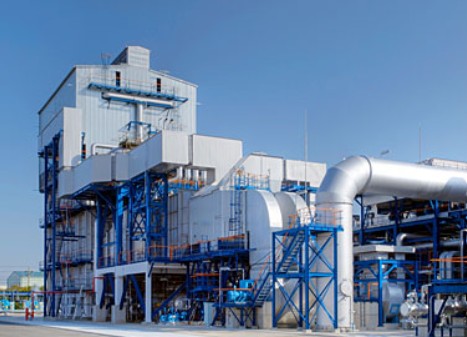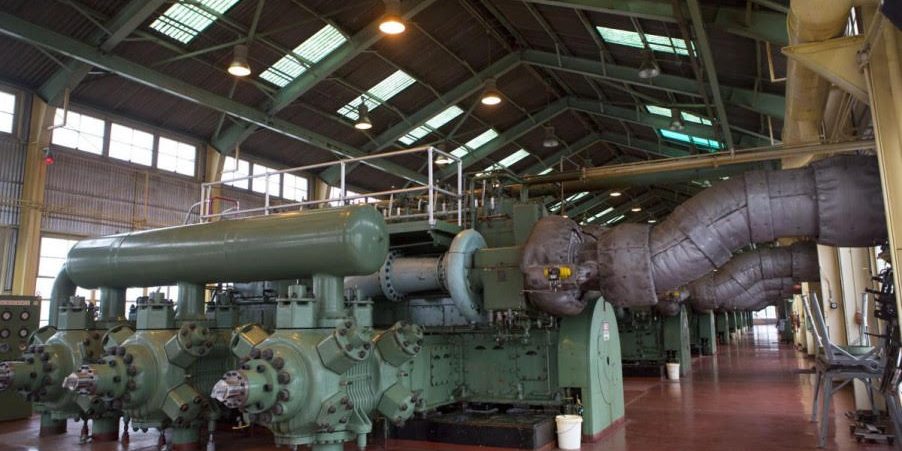Gas Turbine Selection Criteria for Midstream
Power Output & Capacity:
Gas turbines for midstream must be sized with a minimum 26.3% power margin above design requirements to account for throttling losses, filter pressure drops, and operational variations. For typical 50-500 MMSCFD compressor applications, turbine output ranges from 15-50 MW.
The efficiency relationship ![]() shows that efficiency improves with pressure ratio but begins declining after 15-20:1 due to material limitations. Firing temperatures of 1200-1350°C are standard, with higher temperatures requiring advanced superalloys and thermal barrier coatings.
shows that efficiency improves with pressure ratio but begins declining after 15-20:1 due to material limitations. Firing temperatures of 1200-1350°C are standard, with higher temperatures requiring advanced superalloys and thermal barrier coatings.
Fuel Flexibility & Wobbe Index:
Pipeline natural gas composition varies within ±4% of Wobbe Index values. Modern gas turbines employ physics-based control systems to continuously adjust for fuel composition variations including methane (80-95%), ethane, propane, and inert without combustion instabilities, emissions violations, or flame blowout. Aeroderivative turbines offer exceptional multi-fuel capability, operating on natural gas, LNG, LPG, coke oven gas, diesel, or kerosene—often switching without stopping or power derate, providing $12-43 million annual fuel cost savings.
Reliability & Maintenance:
Turbines can achieve 98.6% availability with saving in annual maintenance requirements. Maintenance follows OEM-prescribed intervals based on Factored Fired Hours (FFH) and Factored Fired Starts (FFS): Borescope Inspection, Hot Gas Path Inspection, Major Inspection to be carried out during routine maintenance.
Compressor Optimization for Midstream
Aerodynamic Design via CFD:
Advanced computational fluid dynamics optimization improves impeller blade loading distributions, minimizes boundary layer distortions, and achieves 2-5% efficiency gains. Key optimization parameters include blade angle distributions, impeller exit diameter, diffuser geometry, and tip clearances. Pressure coefficient distribution analysis reduces suction-side peak intensities by creating more uniform blades loading across the spanwise direction (tip, mid-section, root). Modern optimization achieves 0.27-0.50% efficiency improvement with 10.7% power reduction capability. High head-coefficient impellers generate 1.5-2.0 pressure ratios per stage with higher rise-to-surge margins suitable for high compression requirements.
Variable Frequency Drive (VFD) Systems:
VFD implementation reduces energy consumption by 30-33% compared to fixed-speed systems by continuously adjusting motor/turbine speed to match demand. This maintains operating points on the compressor performance curve rather than throttling discharge flow. Typical annual cost savings reach $15k – 20k per compressor with 2–5-year payback. VFD systems enable pressure bandwidth control to ±1.5 psi (versus ±5-10 psi fixed-speed), eliminate high in-rush startup currents, and reduce mechanical stress extending component life.
Inlet Condition Management:
Cooler inlet air dramatically improves compressor performance: reducing temperature from 80°C to 20°C increases output 20.4% through improved air density. Colder inlet air reduces moisture condensation, prevents hydrate formation, and minimizes blade erosion. For every 1°C temperature reduction, power output increases approximately 0.5%. Inlet cooling strategies including chilled water systems and desiccant-based evaporative cooling can improve turbine output 2-15%, with economic analysis required to justify chiller capital costs.
Surge Margin Optimization:
Surge represents complete compression breakdown at low flows or high discharge pressures. Modern CFD methods optimize surge margin through analysis of Mach number distributions rather than traditional iterative approaches, reducing computation time by 33%. Transient Deceleration Ratio (TDR = Mach throat/Mach peak) provides most accurate surge prediction at design point. Industrial practice specifies 10-15% minimum surge margin. High head-coefficient impellers provide smaller rise-to-surge margins requiring tight operating point control; low head-coefficient designs offer wider operating ranges.
Economic and Technical Integration
Aeroderivative Multi-Shaft Configuration:
Multi-shaft design decouples the free-power turbine from the high-pressure assembly, enabling independent speed control and faster response (50 MW/min versus 5 MW/min). Aircraft heritage provides excellent part-load efficiency (40% at 50% load), unlimited turndown capability, and 3600 rpm operation providing 4× higher inertia than 900 rpm reciprocating engines. Modular, lightweight construction enables quick replacement within days minimizing downtime—ideal for remote unmanned stations. Pressure ratios reach 30:1 per stage versus 15-20:1 for frame designs.
Lifecycle Cost Analysis:
Despite higher capital costs, Turbine and compressor systems recover investment through superior efficiency and maintenance savings within 3-5 years. Annual maintenance represents only 2-3% of capital versus frame turbine major overhauls every 5-6 years. Integrated selection of multi-shaft turbines, CFD-optimized centrifugal compressor, and VFD-controlled operation with predictive maintenance monitoring provides optimal system performance for midstream gas transmission requirements





